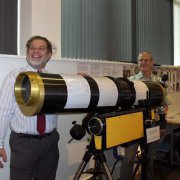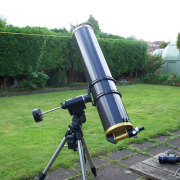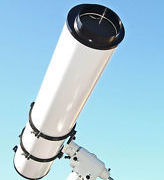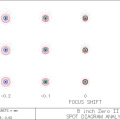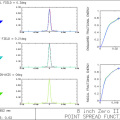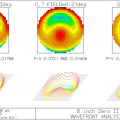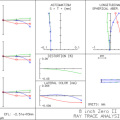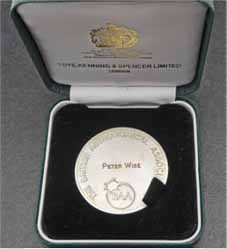ZEROCHROMAT refractor
Anno 2014
UN RIFRATTORE "APO" ECONOMICO
Immaginiamo di volere un rifrattore da 20 cm. di diametro a fuoco medio e con prestazioni di tutto rispetto. Immaginiamo anche di avere poco denaro e di cercare uno strumento compatto e leggero che possa essere sorretto anche da montature standard e in voga tra gli astrofili (EQ6- G11 e similari), e accettiamo di dare credito alle premesse e promesse di questa soluzione...
Con lo ZEROCHROMAT avremmo trovato la “quadratura del cerchio”.
La storia di questo strano schema ottico, che unisce alcune delle caratteristiche degli obiettivi dialitici con quelle dei rifrattori folded, la lascio spiegare dal suo inventore PETER WISE, del Regno Unito, così come appare sul suo sito informativo (e come riporto più avanti).
L’idea di base (che è poi non troppo dissimile almeno dal punto di vista degli elementi a rifrazione da quanto fatto da TAL con il suo 125 APOLAR) è intrigante e dovrebbe permettere, con spesa contenuta, di gestire le aberrazioni a centro campo di una lente singola primaria. Le deformazioni geometriche e cromatiche sono descritte dai grafici riportati e, benché non si sia davanti a una prestazione sull’intero campo permessa da rifrattore apocromatico multi lente moderno, quanto avviene al centro e entro un raggio di 2/3 circa del campo inquadrato sembrerebbe testimoniare prestazioni notevoli.
CARATTERISTICHE
PETER WISE ci racconta questo (lascio in inglese la descrizione per non rischiare di modificarla con la traduzione):
The original concept of the 'Zerochromat' astronomical telescope employed a single plano-convex objective lens, and after the converging rays have crossed over, a field lens brings the rays back to focus with a series of corrector lenses. These comprised two single positive lenses, a negative lens, a doublet lens and a triplet lens.
Over time, the design has been dramatically modified; it now has fewer lenses, and is thus less expensive. The theoretical Strehl ratio has now been increased to 0.995, and star tests prove this out. The corrector system now has one singlet field lens and two small doublets. Stars are tiny pin-points across the entire field of view. The field of view has increased from 0.6 degrees to over 0.75 degrees
The tube is a carbon fibre composite, offering great strength with light weight. It is finished in a high gloss Pantone white, and the end caps are gloss black.
Because of the matt black interior, and the baffling effect of the corrector tube, contrast is exceptionally high. No stray light can escape down the focuser to reduce this very high contrast.
One very clever use of this technology is the ability to eliminate atmospheric refraction near to the horizon by a minor adjustment of one of the collimation screws, which is easily reversed when returning to objects higher in the sky.
Collimation of the small fold flat, close to the objective lens, is set at the factory. It should never move under normal conditions, but may be accessed if necessary. It is very easily set by the use of a laser collimator. The only collimation that may be necessary is with the large fold flat, close to the focuser. While viewing through the instrument, this large flat can be adjusted to provide perfect collimation in just a few seconds. Under normal conditions, it does not move, and the instrument can usually just be taken out of storage and put on the mount with no adjustment necessary.
One very useful aspect of the thin objective lens (just 12mm in the centre), is a very rapid cool-down time. In a fraction of the time taken for most telescopes to cool down, you can be up and observing with no fuss. The carbon fibre tube has very low thermal expansion, and almost exactly compensates for the change in focal length of the objective lens with temperature. Over a 40 degree Centigrade change in temperature, the objective lens changes by 0.35mm in focal length. Over a similar temperature change, the composite carbon fibre tube changes by approximately 0.13mm. When this is multiplied by three, because of the light path being folded, the change is 0.39mm.
Most of the optical work is done at our North Wales workshop, so costs have been slashed to a very affordable level, and the exceptionally high quality can be maintained. An 8 inch achromat from a well-known manufacturer can be purchased for approximately 8,000 Euros, with their 8 inch apochromatic offering at over 35,000 Euros.
The weight of these instruments is only 10kg (22lb), which is half that of a typical 8 inch achromat, and nearly 1/3 that of an 8 inch apochromat. Mounts such as the EQ6 can easily handle the 'Zerochromat' telescope. The tube length is 1530mm, so it is easily transported in a medium-sized car. Only one person is required to set up these telescopes, unlike any other refractor of similar aperture.
We supply these instruments in a handsome black painted birch ply and aluminium flight case, which is foam lined for safety.
An 8 inch refractor is a very desirable instrument, as stated by the late Dr Patrick Moore in one of his books. We can now make this a very affordable goal to achieve at an extremely attractive price.
STORIA E RICONOSCIMENTI
A long-term inventor, especially of optical systems, Peter Wise received the Horace Dall medal from the British Astronomical Association for his contribution to the progress of astronomy in 2007. This followed from his design of the 'Newise' reflecting telescope design, which was prompted by his shoulder-mount 'Evolution' spotting telescope. In 2008, Peter developed the 'Zerochromat' refracting astronomical telescope, which provided excellent image quality from a dialyte design, based on the 30 inch dialyte refractor at Hanwell Observatory, the World's 7th largest refractor, which was invented and made entirely by John Wall, inventor of the Crayford focuser. In 2010, a Gold Medal was awarded to the 'Firefly' 85 spotting telescope at the Geneva Inventions Exhibition. This is another variation on the dialyte configuration; it has not been commercialised at the moment, and efforts have been concentrated on the 'Zerochromat'.
COSTI E CONSIDERAZIONI
Lo strumento (sino ad ora realizzato in pochissimi esemplari: 3 a quanto ne so, almeno fino al giugno 2014 quando ho scritto al suo ideatore) costa circa 4500 euro + spedizione, un valore piuttosto contenuto se rapportato alle paventate prestazioni.
Un esperimento? Il futuro dei rifrattori economici ad alte prestazioni? Un flop? Credo che finché qualcuno di noi non ne proverà uno non ci si potrà sbilanciare in alcun modo ma, sicuramente, la "cosa" è intrigante.

